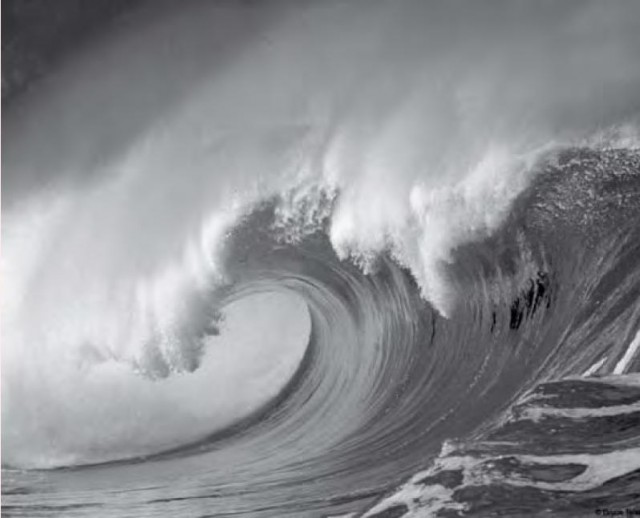Wave power
Although currents both deep and shallow carry billions of tonnes of material around the Earths seas and oceans, waves are the most visible manifestation of the power of the world's water.
Even a lake can contain worthwhile waves. But they are seen at their biggest in major oceans. The highest attested wave, seen during an enormous north Pacific storm by an observer on the US Navy oil tanker Ramapo in 1933, was agreed to be 34m high from crest to trough. This means that the wave would have 17,000 kW of power for every metre of its length, so a 60m stretch would have the power of a large nuclear power station at full tilt. The biggest waves regularly observed occur where the flow of the full ocean is captured and funnelled, as with bores, or when waves meet an oncoming current. This happens off South Africa where major ocean currents collide.
Waves form because as the wind blows across the sea, it rubs against the water surface and makes it slightly rough. As the surface gets rougher, there is steadily more for the wind to grab hold of and the waves get larger.
These waves involve a combination of transverse (up and down) and longitudinal (back and forth) motion, which means they have a movement in which the water particles perform a small circular orbit. This is why waves wash you back and forth a short distance when you are bathing in shallows at the beach. The water itself is not moving along the line of the wave, which is why boats bob up and down as a wave goes past, but are not washed ashore.
The scale of wave activity at any point in the ocean depends mainly on the amount of wind and the'fetch”, the distance it has blown over the water. After a while, waves become “fully developed” which means that the same wind will not make them any bigger even if it blows across the water for a greater distance.

In the deep sea, all this works in an uncomplicated way because the base of the wave does not touch the seabed. But when they reach shallow water, and the invisible part of the wave interacts with the sea floor, the water is forced up and the wave gets higher. When it is one-seventh as high as the distance between waves, it becomes unstable, and collapses more or less rapidly.Then you have a breaker, the surfer's delight. Ideally, a surf beach should have a plentiful supply of ocean waves and a steep seabed that makes the breakers curl over dramatically.
Like light waves, water waves can be reflected and refracted. They can be seen being reflected off harbour walls, reducing the energy of the incoming waves and reducing the erosion they cause. In shallow water, their direction can be bent by refraction. The part that hits the shallows first slows down and the rest seems to bend as it catches up.
There are also waves deep below the surface of the ocean. These are longitudinal waves. Thinking back to p.102, they are like the P waves generated by earthquakes which can travel through the Earth's liquid core. In these waves, the water is compressed and then stretched along the line in which the wave is moving.
